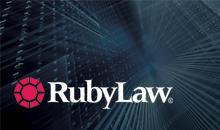How Effective Content Marketing Makes Legal Marketers’ Lives Better
Key Points
—Law firms average up to 10,000 pages of website content
—Legal marketers serve as the fulcrum for Content Lifecycle Management (CLM)
—Firms are incentivized to select marketing technology that delivers competitive advantages
—Switching to RubyLaw CLM can save firms upwards of $100k/year
—Achieving higher engagement with content translates to greater attainment of revenue goals
Although law firms are primarily professional services organizations, they assume second lives as media companies.
An analysis of firms using RubyLaw—a Content Lifecycle Management (CLM) platform that powers law firm websites, experience databases, and proposal generation systems—shows an average of nearly 10,000 pages per firm website. Mind you, this assessment biases Am Law 200 firms. Still, it’s safe to generalize the assertion that Content Marketing represents a foundational piece of law firm marketing and, broadly, the business of being a law firm.
Thus, for firms to practice the art of Content Marketing, they must also practice the science of Content Management.
What is Content Management?
Law firms develop, publish, edit, archive, refresh, and share different types of content as part of their respective go-to-market strategies. Such activities describe the practice of content management. At RubyLaw, we go one step further, layering in the variable of time to express the beginning, middle, end, and renewal of content cumulatively referred to as Content Lifecycle Management (CLM).
Within this context, legal marketers serve as the fulcrum of CLM, collaborating with content authors, editing, and packaging thought capital, and then broadcasting it, with the web being a primary outlet. Supporting the fulcrum (i.e., the legal marketer) is the system as a technology resource.
As we know from Chief Martec, there is no shortage of software solutions to manage content. However, the legal services field is highly specialized yet nuanced, requiring solutions that meet basic requirements and understand legal marketing use cases to deliver a competitive advantage.
General Selection Criteria and Specific Use Cases for Law Firm CLM
When it comes to purchasing technology, all firms make decisions differently. Some choose by committee, with partners weighing in and approving budget; IT influencing and managing security and compliance; and Marketing championing its preferred solution. Others give more purchasing power to Marketing or IT, dependent on which department owns the license or subscription.
Regardless, general selection criteria typically include:
—Core functionality referencing the firm’s use case
—Cost-effectiveness and billing model
—Security strengths and vulnerabilities
—Interoperability with other back-end systems
—Prevalence and preference among peers
—Ease-of-use and onboarding
Law firms must go deeper when evaluating technology when it comes to specific CLM use cases. This has as much to do with them behaving like media companies as it does the uniqueness of how law firms go to market.
To the former, law firms publish immense volumes of content, ranging from client alerts, blog posts, and podcast interviews to news items, practice updates, lawyer biographies, and other forms of thought leadership. Given the sheer quantity and spectrum of content, CLM technology must give legal marketers the ability to:
—Store and access digital marketing assets centrally
—Search for and surface site content quickly and efficiently
—Make content updates globally from a single location
—Manage SEO, e.g., page titles and site metadata
—Optimize and accelerate page load times
—Import and export content en masse using standardized formats
—Support Web Content Accessibility Guidelines (WCAG) 2.0 compliance, as well as adhere to privacy regulations
—Easily manage content without extensive technical expertise or dependence on third parties
For the latter, law firms’ unique go-to-market approach incentivizes them to select systems that can offer competitive advantages. These include table stakes features, per the above, that ensure security, reliability, consistency, scalability, and deliverability. In addition, also included are accelerants and margin-makers. One example here includes RubyLaw’s best practices fields: a set of structured data fields for different types of names for practitioners, like First, Last, Preferred, Nickname, and others.

Given that lawyers may have a given name, a married name, or a more commonly used nickname, searching by using any name type provides firms that use RubyLaw an advantage. Their site visitors can easily find specific lawyers without having to remember that, say, “J.K. Rowling’s” given name is Joanne Kathleen. Jones Walker’s JoJo Adams, whose given name is Joseph, is a prime example of this use case; only the firm has opted to publish both his given and preferred names. In contrast, they could opt for one or the other, and visitors could find him by searching for either Joseph or JoJo.
Going yet a layer deeper, beyond giving visitors an easy way to find the practitioners they’re seeking, is to be able to showcase their relevant credentials to encourage and drive engagement (i.e., business development). While many systems can integrate with other back-end point solutions, RubyLaw includes leveraging RubyLaw Experience—a modular experience database—or connecting via the RubyLaw Connector API to display lawyer experience content on the web. This dynamic offering allows firms to position themselves competitively to win new business and present relevant expertise without requiring Marketing or Knowledge Management to curate experience content on an ongoing basis manually.
Consider Stradling’s Salil Bali, an intellectual property lawyer. His biography includes experience content ingested and displayed by RubyLaw, giving prospective clients an accurate and complete picture of how he and the firm might provide expert services.
One final example is the challenge of spinning up new pages in response to trending or emerging topics. Legal marketers are frequently in a pinch, responding to various pressing issues. For example, when the COVID-19 pandemic exploded, firms needed to act quickly and share information with internal and external constituents. Most created “COVID Resource Centers” to house content about policy and regulations, best practices, as well as their protocols for managing client relationships.
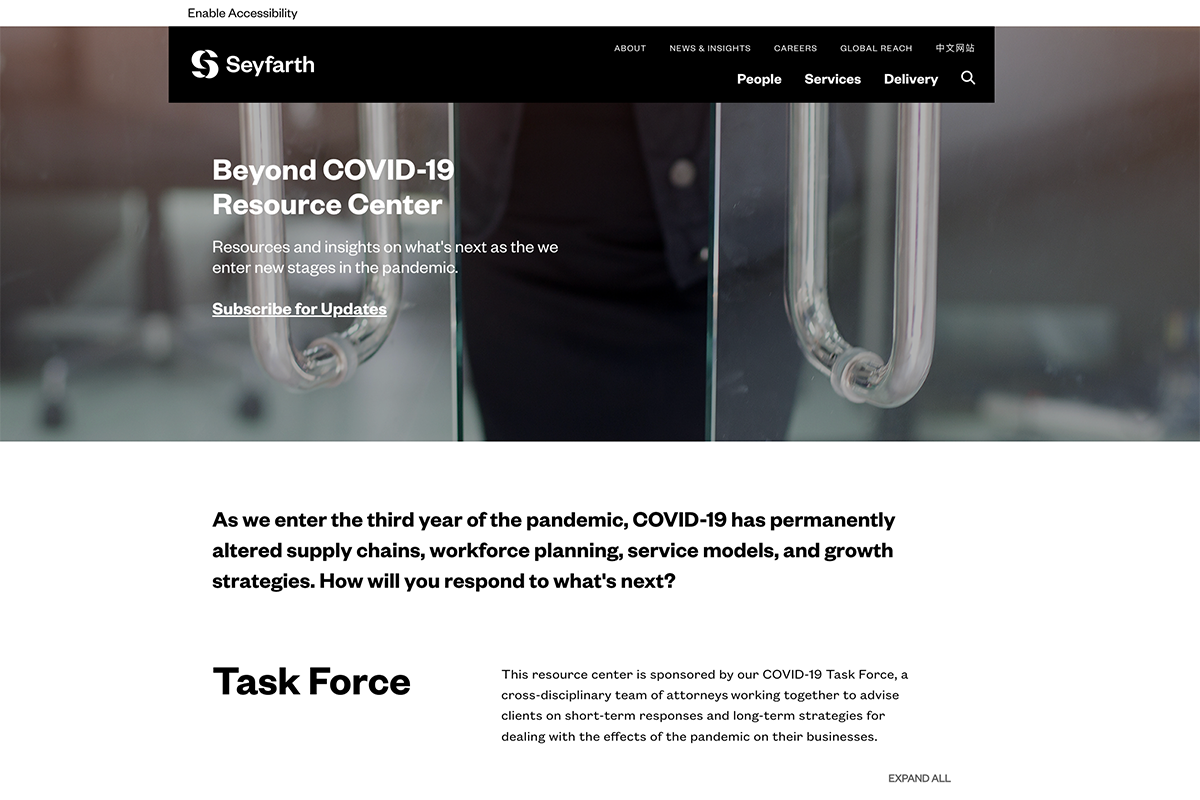 Those with flexible systems, like RubyLaw CLM, that launched new sections or resource centers overnight could keep relevant parties informed in real-time. Seyfarth is a standout firm in this regard. Using the modular RubyLaw Super Template, the team created the Seyfarth COVID-19 Resource Center, a self-directed resource to guide clients on short-term responses and long-term strategies for dealing with the effects of the pandemic on their businesses.
Those with flexible systems, like RubyLaw CLM, that launched new sections or resource centers overnight could keep relevant parties informed in real-time. Seyfarth is a standout firm in this regard. Using the modular RubyLaw Super Template, the team created the Seyfarth COVID-19 Resource Center, a self-directed resource to guide clients on short-term responses and long-term strategies for dealing with the effects of the pandemic on their businesses.
What’s truly remarkable about this resource center is that the Seyfarth team repurposed its 2019 Year in Review pages, constructed using the RubyLaw Super Template to create a new, brand-aligned experience to house an emerging topic (i.e., pandemic content). Even more remarkable is that they did it without any third-party assistance.
Getting Law Firm CLM Right
Rather than looking at the scary costs of getting CLM wrong, let’s consider the benefits of getting it right. First, let’s appreciate the financial and temporal savings. In terms of investment dollars, as we’ve previously shared, switching to RubyLaw can save firms upwards of $100k/year. These savings are a function of time reserved from context switching and collaborating with timekeepers to managing more in-house by non- or lesser-technical users. The result is improved control, faster outputs, and a happier working environment—at least, a less stressful one when managing content.
Second, having an intuitive system designed for the particularities of legal services provides a marked advantage over sector-agnostic systems. This decreases the time configuring the system to work to your style and builds on the best practices that guide users through better, more effective ways to manage content. Such organizational tools provide a framework and give firms confidence that they can conduct CLM in one place and maintain brand and content integrity.
Finally, business results come from past savings, peace of mind, and best practices. A system like RubyLaw can deliver and distribute content globally, better, and faster than other solutions. It displays the most current and accurate firm and lawyer experience under your brand, prospects, clients, and internal stakeholders. This allows more understanding, which can make identifying with the full breadth of your firm’s offerings easy. This, in turn, translates to higher engagement with your content and, ultimately, attainment of revenue targets.
With all the growth and savings resulting from switching to RubyLaw, legal marketers and their firms can worry less about their second lives as media companies and focus more on putting their attention, time, and passion to whatever’s important to them (i.e., serving clients, doing meaningful work, and living their best lives).
References
Brinker, Scott. “Marketing Technology Landscape Supergraphic (2020): Martech 5000 - Really 8,000, but Who's Counting?” Chief Marketing Technologist, 23 Apr. 2020, https://chiefmartec.com/2020/04/marketing-technology-landscape-2020-martech-5000/.
“Covid-19 Resource Center.” Seyfarth Shaw - COVID-19 Resource Center, https://www.seyfarth.com/covid-19-resource-center.html.
“Joseph ‘Jojo’ L. Adams: Jackson Labor & Employment Attorney.” Jones Walker LLP – Joseph "JoJo" L. Adams | Jackson Labor & Employment Attorney, https://www.joneswalker.com/en/professionals/joseph-jojo-lee-adams.html.
“Marketing Briefing on Productivity Platforms.” RubensteinTech, https://x.rubensteintech.com/en/rubylaw-platform-briefing-marketing
Rubenstein, Jaron. “Introducing Content Lifecycle Management (CLM) for Law Firms.” RubensteinTech, 10 Sept. 2019, https://www.rubensteintech.com/innovate/introducing-content-lifecycle-management-clm-for-law-firms.html.
“Salil Bali.” Stradling, https://www.stradlinglaw.com/professionals/salil-bali.html.

